BABYLON AND THE ROYAL GAME OF UR
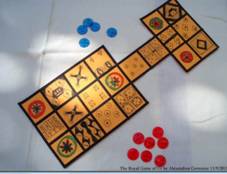
Unit Overview
From the Code of Hammurabi to the Epic of Gilgamesh, ancient Babylon is known for its contributions to learning and culture. This society’s remarkable achievements, including farming and the domestication of animals, gave the Babylonians time for other pursuits. It was not long before leisure led to games. Today, a few museums display boards used to enjoy the royal game of Ur, and scholars throughout history have made educated guesses as to how this game was played. In this unit, you will make your own board and apply your skills in this ancient game.
Babylon
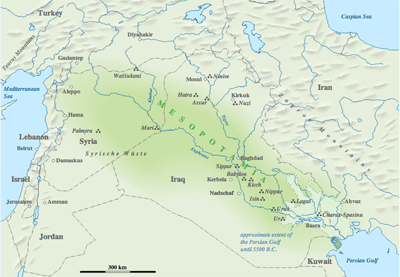
This area of the Middle East has been called 'the cradle of civilization.' While the civilization flourished over 3000 years ago, many of our modern day concepts arose in this area and from the numerous civilizations that grew here in what came to be known as 'the Fertile Crescent.'
The Babylonian Empire came from two earlier kingdoms, those of Sumer and Akkad. We know a fair amount about this period of time because their writing system, cuneiform, and their writing method (inscribing clay tablets) have withstood the ravages of time and are readable today (dried clay is much tougher than paper when stored beneath the earth in crypts and ruins).
Daily Life
People in Babylon lived in great walled cities built out of dried mud along the banks of two great rivers, the Tigris and the Euphrates. The people built an intricate system of canals to irrigate the hot and dry land. They were some of the first to farm and domesticate animals. We know a great deal about the civilization because they left many written records.
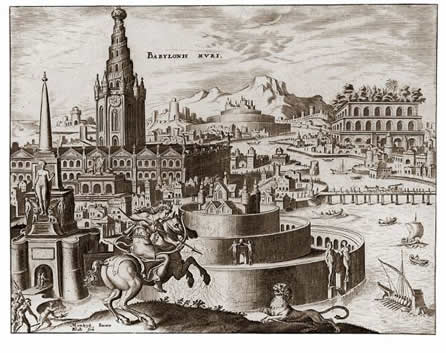
Religion
People who lived here practiced polytheism, the worship of many gods. All believed that the afterlife was a great struggle, which mirrored their own lives in the harsh desert.
Kings ruled by divine mandate, and the king was assumed to be serving at the pleasure of the patron god of that city-state. In most of their cities, the King was the same person as the High Priest of their god. This is different than what you will see in Egypt, where the Pharaoh was viewed as a god. In Babylon, the King was not a god but the god's right hand man.
Laws and Government
Hammurabi was a famous king of Babylon who established a code of laws, called (appropriately enough) Hammurabi's Code. This code is where the term 'an eye for an eye' came from, as the code specified punishments for various crimes. This listing of law is where our modern sense of 'justice' originated. Since Babylonians probably grew weary of ruling separately for every argument that was presented to them, they codified a list.
Example: "If anyone opens his ditches to water his crop, but is careless, and the water floods his neighbor's field, he shall pay his neighbor corn for his loss."
Mathematics
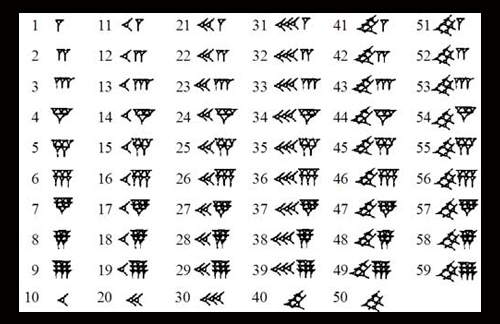
Great strides in math were made during this time period, driven by the desire to understand the movement of celestial bodies (the heavens) and predict their appearance. Many mathematical concepts in our modern lives came from this civilization.
Babylonian math used base 60, resulting in the use of 60 seconds in a minute, 60 minutes in an hour, and 360 degrees in a circle. The Babylonians used this math for two reasons:
- 60 has many divisors, making calculation easy
- Babylonians used a place-value system, where numbers to the left represented larger values (such as the number '423' which equals 4-100s, 2-10, and 3-1s).
Babylonians accurately calculated the square root of two and discovered the Pythagorean Theorem long before Pythagoras.
Astronomy and Astrology
Astronomy and astrology were important to the ancient Babylonians. Astronomy, the study of the heavenly bodies (stars, moons, planets, comets) , is a modern day science. Astrology is the study of how those bodies affect and interact with our destinies and is a modern day pseudo-science. In Babylon, astronomy and astrology were viewed as one science. When the citizens of ancient Babylon discussed issues such as how the moon affected tomorrow's events, or what sign their child was born under, they believed the answer to be true in the same way we believe that when you drop an apple, it will fall to the earth.
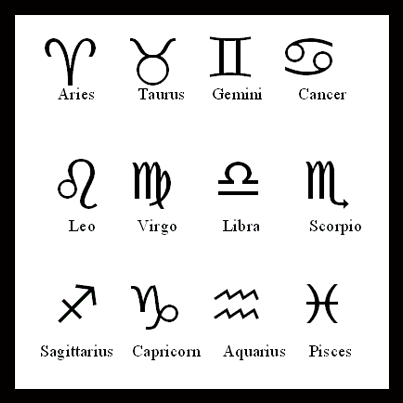
Astronomers in Babylon were highly paid consultants who viewed the movement of the heavens and made predictions based on those movements. They needed accurate math to make predictions. They created the 12 houses of the Zodiac and (Zodiac; they also) identified and named these constellations.
Literature
Enheduanna is known as the first poet. You may enjoy reading The Epic of Gilgamesh. The epic poem dates from around B.C. 2000. It tells the tale of a hero named Gilgamesh.
The History and Discovery of Ur
The Royal Game of Ur refers to two game boards found in the Royal Tombs of Ur by Sir Leonard Woolley in the 1920s. The two boards date from the First Dynasty of Ur , before 2600 BC, making the Royal Game of Ur the oldest board game ever found. One of the two boards is exhibited in the collections of the British Museum in London. You can also follow this link for the British Museum to get a general idea of how the game is played.
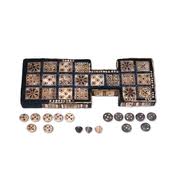
We don't know for sure exactly who played the game. It was found in the Royal Tombs, but that doesn't necessarily mean only royalty played games. The Royal tombs are the best preserved, so it is easier for those artifacts to withstand the ravages of time. When you play the game, think about whether you can picture peasants and royals alike playing it.
Build Your Own Game
Try building your own playable copy of the royal game of Ur after looking at the images provided in this unit. Remember--your game board has to be sturdy enough for you to play. You can download the template or use a program on your computer to draw the base for your board. The board and playing pieces for the royal game of Ur can be made from paper or cardboard. Checker pieces or stones can also be substituted for playing pieces. You will also need four or six-sided dice.
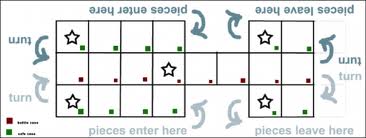
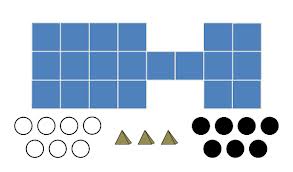

The Rules
You are now ready to play the game on your newly created game board. The Royal Game of Ur was played with two sets of seven pawns (one black and one white) and three four-sided dice. The rules of play are not exactly known today, but we have an educated guess.
This is a race game. The goal is to introduce the seven pawns, to move them along your designated path, and to be the first to have all the pawns out of the game, similar to backgammon. The start square for each player, the path followed by each player, and the five special, rosette squares are shown in the images below. The exit square is the one between the two rosettes (left hand side of the image). The board layout shows the players entering from the squares to either side of the exit square.
The game can be played by more than two players, but we suggest that two play at a time for sanity's sake. We also suggest that you create multiple boards and sets of pieces so students can play in teams of two or four.
Movement points are determined by the roll of the four-sided or six-sided dice as follows:
- three odd numbers gives the player 5 movement points and after moving the player rolls again
- three even numbers gives 4 movement points and after moving the player rolls again
- two odd numbers yields zero movement points and, after moving the turn ends
- one odd number gives 1 movement point and the turn ends
- Roll all three dice, sum the total and the highest total roll goes first
- The board is empty at the beginning. Pawns may be placed on your first square by rolling three odd or three even; if a pawn is placed, no other movement can occur that turn.
- Any pawns already on the board may advance one square along your path for each movement point.
- A player may have as many pawns on the board as they wish. Each square, except for the rosette squares and the exit square, may be occupied by one and only one pawn at any time. The rosette squares and exit squares are 'safe.'
- Except when they are on the safe squares (see point four above) or have entered the central line, pawns may be attacked by opposing pawns moving in the same direction. If a pawn lands on a square already occupied by an opposing pawn, the opposing pawn is removed from the board and has to restart the game from its start square (entering on an all odd or all even roll as noted above ).
- The rosette squares and the last square are safe: several pawns of different colors may be present without any danger.
- Each pawn may only reach the exit square on a roll of all odds or all evens (in other words, the player may only exit a piece during turns in which they roll all evens or all odds).
- Moving a pawn off the board does not use movement points.
- The winner is the first player who moves all of his or her pawns off the board.
Another explanation of the rules can be found here.
We recommend two players per game, though the game can be played by more than two players at once. Each player will need seven playing pieces. Each game will require three dice (either four or six-sided dice).
